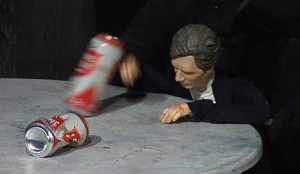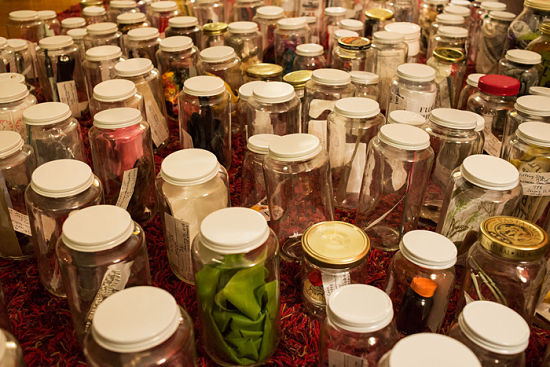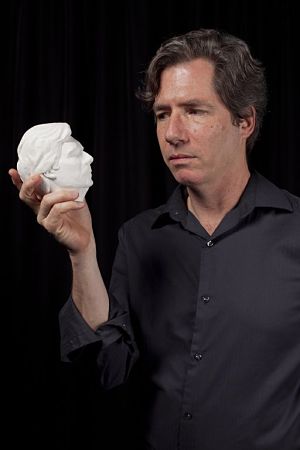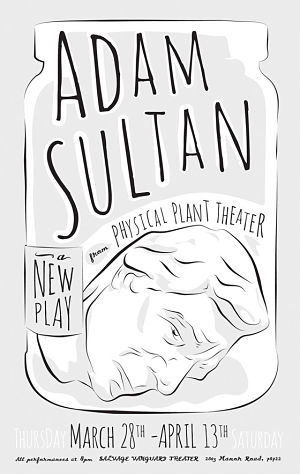Review: Adam Sultan by Physical Plant Theatre
by David Glen Robinson
For the committed theatergoer, this was a long-awaited premiere. The blended live-action and puppet play previewed at the 2012 Fusebox Festival. The preview tantalized audiences with its potential for taking many different directions.
The premiere at the Salvage Vanguard Theatre on March 28 satisfied our aroused curiosity with a long sequence of wise story choices. They took us through some surprising ways yet never strayed from its emotional heart. Sure, it was about death, and innovative puppetry sustained all its moods and action; at the same time the production remained light, humor-filled and entertaining. A demanding ticket buyer couldn’t ask for much more.
The play follows the character of Adam Sultan, played by the artist Adam Sultan, through to the far distant future of A.D. 2052 (not quite forty years from now). Aged and infirm, Sultan sees and feels the loss of his artist friends all around him. Seemingly despairing, he collects mementos of their lives and seals those objects into glass jars. His bookshelf fills with the jars. Then one day a half-scale doppelgänger puppet enters his apartment, drinks heavily and passes out. Sultan doesn’t know what to make of it; he never does know what to make of it. What’s sure is only that from this point forward puppets carry equal weight with human actors in conveying the story and its meanings.
 The Physical Plant team of Steve Moore and Zeb L. West wrote and crafted the show. In addition to makiing unerring choices in a mature story revolving around death, they incorporated advanced concepts of new puppetry that took Adam Sultan to the edge of theatre and puppetry. Completely black-garbed puppeteers were visible onstage. In conventional theatre, anyone wearing black is a technician and therefore invisible in the sense of operating the play and not figuring in the scripted action; technicians are merely making it happen.
The Physical Plant team of Steve Moore and Zeb L. West wrote and crafted the show. In addition to makiing unerring choices in a mature story revolving around death, they incorporated advanced concepts of new puppetry that took Adam Sultan to the edge of theatre and puppetry. Completely black-garbed puppeteers were visible onstage. In conventional theatre, anyone wearing black is a technician and therefore invisible in the sense of operating the play and not figuring in the scripted action; technicians are merely making it happen.
The Adam Sultan puppeteers pushed this envelope or bent this frame in several ways. First and most fundamentally, the puppeteers manipulated and changed the human actors throughout the play; they did so subtly and tellingly when they reshaped the postures and stances of the living to reflect advancing age, as for example in the touching moment when they placed wedding rings on the fingers of the lead characters. In addition, the puppeteers removed their black headgear to speak narrative voice-overs at a microphone stand at stage left. With this, the audience no longer held the puppeteers comfortably framed in invisibility as helpers for the story. Attention, audience: they might do other things, so be ready.

And all this continued: in the human Adam Sultan’s deepest crisis of soul, puppeteers appeared one by one and donned memento items that had been smashed out of their shelved jars. In this way, the puppeteers became the ghosts of Sultan’s past, wearing eyeglasses, beards or ballet slippers. They became apparitions confronting Sultan to drive him to even profounder realizations. This turn was a near-brilliant take on the device of the instructive ghost favored by Shakespeare, Dickens, Goethe, Poe, Byron and other greats. The refreshing use of such an ancient device also had layers within layers: I shall always remember the green eyeglasses worn by the puppeteer with the form of Caroline Reck, who had earlier portrayed Adam’s wife Karen, by that point deceased.
Some of the other devices worked less well. In the hospital scene the puppeteers remained fully garbed and portrayed doctors and nurses treating a human character patient. This was an evident transformation from puppet manipulation to actor portrayal. In union states, the actors union goes to war with the technicians union over technicians doing actors’ work and vice versa. The play should have brought on actors to give Noel Gaulin’s lanky frame an alcohol bath and take his pulse, shaking their heads. Here the play blended the forms a little too much and lost its edge, if only briefly.
As noted above, some of the cast assumed dual roles as puppeteers and human characters. Credit for this heightened creative work goes to Caroline Reck, Kelli Bland, and Noel Gaulin. And possibly to Ellie McBride and Meredith Balderston, although I could not confirm the identities of these latter two through their puppeteer garb.
Full of moments and innovations, the play offered enough to please a wide range of theatrical tastes. Another example: a large garment was thrown through a set window. Puppeteers unrolled it like a film projection, holding it up with a mop and broom and pulling it across a stage segment. It was revealed to be a giant scarf with alien-looking calligraphy and rebus symbols of computer screens, canoes and other objects. A voice-over “read” the scarf as a message from one puppet to another. This was a nearly unprecedented theatre moment appealing to all, from aged theatre aficionados to the skateboard-and-graffiti crowd out on the concrete. Program credit for scarf calligraphy went to Katherine Kiger. It must be noted also that Adam Sultan performed one of his songs in the party (I don’t know if he composed it for the show). In this show the talent oozed all over the stage and into the audience and lobby outside.
 For all its innovation, Adam Sultan was measured and largely devoid of excess. The show stayed on track, and the largely understated acting assisted the total effort. Part of the hospital scene showed some imbalance in this regard, however. After all, the patient portraying Noel Gaulin was the irrespressible Noel Gaulin.
For all its innovation, Adam Sultan was measured and largely devoid of excess. The show stayed on track, and the largely understated acting assisted the total effort. Part of the hospital scene showed some imbalance in this regard, however. After all, the patient portraying Noel Gaulin was the irrespressible Noel Gaulin.
The split time or fractured-universe fantasy of puppets and human characters interacting was wisely left unexplained. Scenes of puppetry and full-scale human acting were repeated exactly but out of sequence, as in a Tarantino film, and keyed on one line of a joke that ran through the play. Noel Gaulin finally told the joke to its finish as he lay dying and laughing, being swathed in black sheets. The image was remarkably like those of images of saints and celestial beings in Renaissance and Baroque paintings, wrapped billowing cloths and clouds -- with the garments updated to fashionable black to suit modern tastes.
Adam Sultan is a generous sharing and a fervent appeal to the world to find the joy in living every moment. Artists, too often are self-isolating and bound up obsessively in their artistry, need this message and frequent reminders of it. Physical Plant Theater conveyed the message boldly and colorfully in Adam Sultan.
Comment by Spike Gillespie at her blog Spike Speaks, March 30
Review by Cate Blouke for the Statesman's Austin360.com Seeing Things blog, April 2
Feature by Robert Faires for the Austin Chronicle, April 5
Review by Wayne Alan Brenner for the Austin Chronicle, April 5
Hits as of 2015 03 01: 952
Adam Sultan
by Steve Moore and Zeb L. West
Physical Plant Theatre
